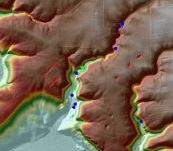Lidar Data for Minnesota
Elevation Home |
Lidar |
Raster Data/Shaded Relief |
Contour/Point Data |
Topo Maps |
General Info
 Lidar ("Light detection and ranging")
is an active remote sensing technology that uses laser light to detect and measure surface features on the earth. Lidar-derived high-resolution elevation data products are available for all of Minnesota.
Lidar ("Light detection and ranging")
is an active remote sensing technology that uses laser light to detect and measure surface features on the earth. Lidar-derived high-resolution elevation data products are available for all of Minnesota.
Featured Resources
- Minnesota Geospatial Commons: Search on "lidar" to find lidar elevation and hydrography data, hilldshades, and more lidar datasets and derivatives for Minnesota
- Minnesota Lidar Hub: The latest lidar information for Minnesota, including availability of data from the 2021-2025 statewide lidar acquisition
- Minnesota Lidar Plan: Aquisition plan for the 2021-2025 lidar collection in Minnesota
- Minnesota Lidar Plan StoryMap: An introduction to lidar, how it is used in Minnesota, and the need for the 2021-2025 lidar acquisition.
Statewide Lidar Data Collections
Two statewide lidar data acquisitions have taken place for Minnesota - visit the collection you're interested in to find more information and access the data and related derivatives:
- 2008-2012 Statewide Lidar Collection
- 2021-2025 Statewide Lidar Collection **Webpage coming soon! Visit the Minnesota Lidar Hub for more information.** A Minnesota web application is being developed to make this data collection and related derivatives available. As the lidar data is processed, it is also made available on the USGS National Map, making the National Map a good resource to access the data until the Minnesota application is completed. See the interactive lidar status map for which areas are currently available on the National Map.
Uses of Lidar in Minnesota
Examples illustrating how lidar data is being used in Minnesota:
- Protecting water quality
- Minnesota Solar Suitability Analysis project, which used Minnesota's statewide lidar data, wins Esri Climate Resilience App Challenge award
- View more lidar use examples on the Minnesota Lidar Hub, including uses by local government and for feature extraction!
Education and Training

- Training Modules, Webinars, and Tools
- Conservation Applications of Lidar (University of Minnesota)
Six training modules on conservation applications of lidar. Each module was taught as a half- or full-day workshop at locations around Minnesota.
- Webinars:
- Using Lidar data to Advance Local Conservation Work: An overview for managing administrators and non-technical staff, Tim Loesch, MN Dept. of Natural Resources, recorded June 12, 2013
- Using Lidar-based Terrain Analysis Products, recorded May 22, 2013
- Hydrology and Terrain Analysis Tools for Using Lidar Data (NRCS)
Free python-based ArcGIS tools- Webinars
- Hydrology and Terrain Analysis Tools, introduction to the tools, recorded February 6, 2013
- Lidar-Based Design of Water and Sediment Control Basins: March 19, 2013 (only the introductory slides are online since the original webinar had technical problems)
-
Download the tools: as one zip file
(updated: v. 1.1.14, 1/26/18)
- Webinars
- Conservation Applications of Lidar (University of Minnesota)
-
Glossary of Lidar-related Terms
- 2013 MN GIS/LIS Consortium Conference Presentation
- Accessing and Viewing Minnesota Lidar Data On-line, Tim Loesch, MnDNR (25 slides, 5MB, PPTX)
-
Lidar and DEM Tips and Tricks
(9 MB, PPT), Tim Loesch, MnDNR, 2011
Tips to help effectively display Lidar and DEM data.
-
Accessing and Using Minnesota Lidar Data Packets
(2.4 GB, zipfile), Tim Loesch and Shelly Sentyrz, MnDNR, 10/5/11
Powerpoint slides, exercise materials and data from a GIS/LIS Consortium workshop.-
Slides only
(29 MB, zipfile)
-
Slides only
(29 MB, zipfile)
- Esri Training
Search on "lidar" in Esri's Course Catalog.
-
3DGeo Education Workgroup
Identifies education and training needs.
Programs

- Minnesota Elevation Mapping Project
A State of Minnesota Legacy Amendment project to complete lidar coverage of the state.
- 3DEP
The primary goal of 3DEP is to systematically collect enhanced elevation data over the United States and the U.S. territories. -
Red River Basin Mapping Initiative
The goal of the Red River Basin Mapping Initiative was to use lidar to develop a high resolution DEM for the Red River of the North Basin south of the Canada-U.S. border.

